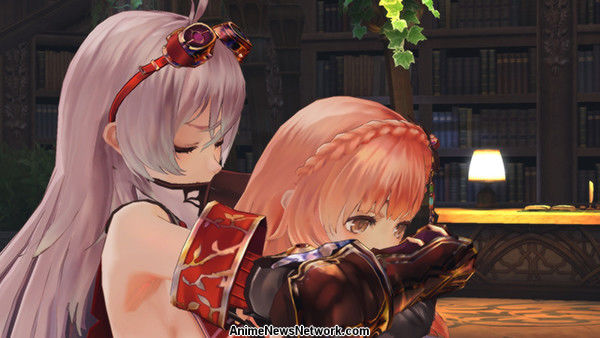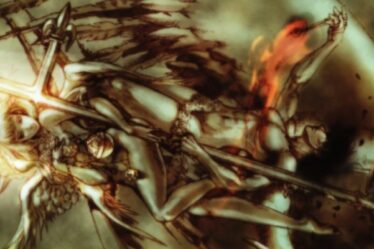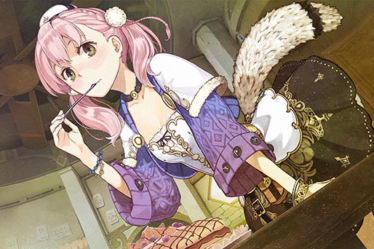
This article was originally published in Italian on Thegamesmachine.it in 2016.
After wrapping up two JRPG trilogies in the previous generation and reviving the Ar Tonelico series under the Ar Nosurge banner, the team at Gust, led by Keisuke Kikuchi (Deception, Project Zero), dives headfirst into fast-paced, almost brainless action with Nights of Azure, the subject of this review. The story centers on the relationship between Arnice and Lilysse, the beautiful protagonists featured prominently in all promotional material. An eternal night is approaching, and it’s up to the silver-haired Arnice and her well-endowed childhood friend to put an end to the threat posed by demons and the mysterious Blue Blood—a liquid that transforms anyone it touches into a mindless beast.
With such a generic premise, it’s no surprise the story focuses on the (rather predictable) duality between the two captivating heroines, bound by a bond that is clearly deeper than friendship but never truly explored beyond textual flashbacks (reminiscent of the famous “dreams” in Lost Odyssey) and a few adolescent side scenes. Arnice embodies the archetypal JRPG hero, torn between her half-human, half-demonic nature, while Lilysse is often depicted in an ambiguous light, perpetually torn between what she wants to do as a woman and what she’s duty-bound to do as the Saint. This overused trope—poorly executed in this case—would almost merit outright dismissal if not for the strong atmosphere and artistic direction that elevate the experience. The tone of the game, centered on the troubled relationship between the two, is decidedly dramatic, with tension lingering throughout the adventure. Thankfully, this is offset by a solid supporting cast and humorous moments where the demons Arnice summons stand out with their unique personalities, often tied to their appearance and combat abilities.
While the game succeeds during its lighter moments (though it caters heavily to the tastes and quirks of Japanese storytelling, complete with maid outfits and inexplicable nudity), paradoxically, the same cannot be said for the key story beats exploring the protagonists’ relationship. Lacking any substantial backstory to flesh out their origins or the development of their bond, the exchanges between the two often feel forced and insincere, as if straining to inject drama at all costs. This approach seems aimed at giving depth to a product that is clearly shaped by inexperienced hands, both in terms of writing and action game development. In the end, Nights of Azure is enjoyable and the story remains passable despite its flaws, but for a title that prominently features a declaredly lesbian couple on its cover, I expected a bit more courage.
That said, between flashy special moves, monstrous creature summons, and various side quests, the game maintains a fast-paced, engaging rhythm. This is thanks to several clever design choices that, while fragmenting the narrative, successfully highlight the hack-and-slash origins of Nights of Azure. At times, it feels almost indistinguishable from a Dynasty Warriors installment, save for its distinctly manga-inspired aesthetic. Despite its relatively low difficulty, Nights of Azure offers an open-ended adventure where players can choose what to tackle and when to advance the main story. The central hub of the adventure is a hotel that not only provides access to the game map but also manages side quests, an arena for optional challenges, and shops. Additionally, the hotel allows players to freely develop Arnice’s abilities and those of her summoned creatures, much like the alchemy labs in the Atelier series. On the one hand, the management elements are simple yet varied enough, while the exploratory phases (limited to fifteen-minute sessions) introduce players to the game’s action-oriented gameplay. Unfortunately, in this area, Nights of Azure struggles to shine, primarily due to barebones level design and a combat system that, while gaining depth as the story progresses, never becomes particularly engaging.
Progressing through the corridors connecting various zones of the game’s island setting is straightforward; battles, despite adhering to JRPG staples like elemental affinities and weaknesses, are often solvable in the same way: mindless button-mashing and spamming special attacks. There’s no shortage of flashy moves to unlock, diverse weapons to wield, and a good roster of demon servants to summon in chaotic moments. However, the few game-over screens I encountered were never due to my inability to handle enemy attack patterns (which are virtually identical across foes) but rather to the lack of an on-screen indicator warning me that my health was critically low. If not for its fast pace and lightweight structure, which rewards pick-up-and-play enthusiasts (let’s not forget Nights of Azure was originally launched in Japan for the PS Vita), this would be a hard sell as a recommended action game.
Finally, moving on to the technical aspects, Gust’s latest effort is clearly tailored to last-generation hardware. The characters are attractive and well-designed, thanks to careful shading and Yoshiku’s striking illustrations. However, their animations are stiff and unconvincing. Nights of Azure doesn’t stray far from the standards established by the Atelier series, with sparse environments, simple topography, and characters that look great in static poses but lack grace in motion. Although the game was developed with PS Vita in mind and launched in Europe as a PS4 exclusive, I noticed frame rate drops during the most action-packed sequences, which makes me skeptical about the portable version’s performance. I wonder if Gust’s next title, Atelier Sophie, will suffer from the same technical shortcomings…


